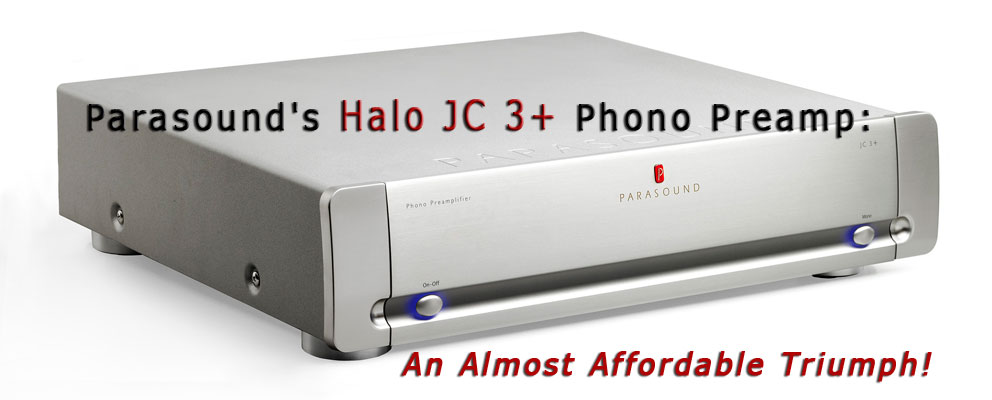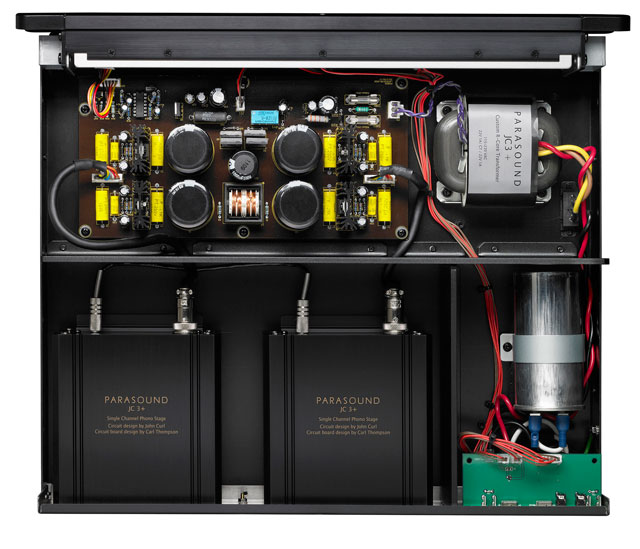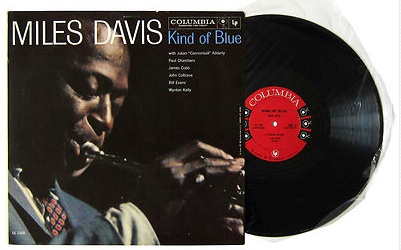Parasound Halo JC 3+ Phono Preamp

First Appearances Don’t Have to Be Deceiving
In Stereo Time’s 2015 Most Wanted Components round-up, I described Parasound’s (and electronics wunderkind John Curl’s) latest thinking on affordable phono pre-amplification, the relatively new JC 3+ ($2,995), as quite the sonic upstart. While not the last word in hyper detail (for that you are going to have to spend a lot more do-re-mi), I praised this sturdy, well-built unit for its dynamic, open, and surprisingly sweet sound. Nothing has happened since then that makes me want to change my earlier opinion. If anything, my admiration and respect for the JC 3+ has only grown.
Longtime readers are no doubt aware that Curl and Parasound’s redoubtable head honcho – Richard Schram – are responsible for bringing to market the stellar JC 1 monoblock amps over a decade ago. The superb JC 2 line stage followed a few years later. Both components share similar sonic and design traits: extremely low noise floors; airy, holographic sound; an utter absence of grit or grain; see-through transparency; a distinctly muscular, if sometimes lean footprint; near state-of-the-art measured performance; and the Parasound Halo line’s handsome champagne casework (and now also black).
The JC 3+ follows in most of the footsteps of its older siblings. It features top-flight components, superb but not over-the-top build quality, low noise, multiple cartridge loading options, and generally excellent sound. But, if you were expecting the JC 3+ to follow in precisely the same sonic footsteps as the JC2 line stage, its natural partner, think again. While both units are, as noted above, blessedly quiet, the phono stage’s lusher, richer voicing paints with a more saturated tonal brush. When paired with the leaner sounding JC 2 (my current reference), the results are magical: impressively wide dynamics, superb neutrality, excellent detail retrieval, wide staging, holographic imaging, and more than a whiff of the air and ambiance one gets from great tube gear.
In the real world, it doesn’t get much better.
Yes, there are better phono stages available. Pass Labs’ two-box, reference-caliber XP-25 comes to mind. So too does its not inconsequential $10,600 price tag. The surprisingly flexible and highly musical Zanden 120, priced at a more approachable $7,500, also warrants a second look, and a third and fourth, too. But for vinyl addicts on a budget (I realize, of course, that $2,995 only qualifies as “affordable” or “quasi-budget” in the zany high end universe), the JC 3+ offers everything any rationale purchaser could ask for. It is the kind of component that works wonders with $3,000 turntable-tonearm-cartridge combinations, but won’t sound out of place with combinations costing three times as much.

Design highlights
The JC 3+ replaces Parasound’s earlier and highly regarded JC 3 model. Introduced in 2011, the previous model met with near universal acclaim. Externally identical to the newer model, the JC 3 featured 68dB of gain for MC cartridges, 47dB for MM cartridges, excellent S/N ratios, low noise, but only two standard loading options for lower output cartridges: the ubiquitous 47k Ohm option for low-output moving iron cartridges like the excellent Grado and Soundsmith models, and the 100-Ohm loading option for standard MCs. Truth be told, the standard 100-Ohm option suits many MCs just fine. My Dynavector 20X2 MC cartridge (the low output version), for example, sounds just fine when loaded at 100 Ohms, but somewhat better balanced and more open at 150 Ohms. Most Koetsus love the 100-Ohm option, as do droves of other fine MCs, including some very pricy models. But, if you own a cartridge that doesn’t like the 100-Ohm setting, or if you use detachable head shells and swap cartridges on a weekly basis, the JC 3 was probably not the phono stage for you.
Trouble is, adding variable loading options invariably involves additional components and the potential for added noise and compromised sound quality, compromises that neither Curl nor Schram were willing to make at the time. Fast-forward a few years. Faced with rising demands from the marketplace for greater loading options, Curl and Schram decided that capitulation was the better part of business valor, but only if the final product didn’t compromise sound quality.
Enter the good folks at Vishay. After lengthy negotiations, Curl and Schram were able to secure custom-made, low noise, dual gang potentiometers from Vishay that offered independent and variable MC loading for each channel from 50-550 Ohms. Given that firms the size of a Vishay typically won’t supply such complex components in the smaller batches that Parasound required, I think it’s safe to say that the success of this endeavor owed in no small part to Richard Schram’s skills as a negotiator, and the high regard with which Vishay obviously holds the legendary Mr. Curl.

Other improvements over the JC 3 include a beefier power supply with 47% larger low ESD power supply filter caps, an 82% larger R-core power transformer, and Curl-Thompson circuit refinements (Carl Thompson designed the circuit boards for the Vendetta phono preamps and CTC Builders Blowtorch preamp, as well as the Parasound JC 1 and JC 2 boards). All of these improvements, plus the Vishay potentiometer upgrades, only added $600 to the unit’s price. The JC 3+ retains its predecessor’s completely dual-mono circuit board arrangement, a single RCA input, but the choice of either single-ended or balanced outputs. I used the unit’s balanced outputs exclusively. To my ears, the sound through the balanced outputs was noticeably quieter, with wider dynamic contrasts, and more harmonic richness. Interestingly, Curl and company reduced maximum MC gain from 68dB to 64dB in order to minimize the risk of overloading some preamps. On the flipside, MC S/N ratios have improved quite a bit (87dB, A-weighted for the 3+ versus 75dB, A-weighted for the JC 3). Finally, for those with sizeable mono LP collections, the JC 3+ features a mono switch on its front panel that noticeably improves the sound of older recordings versus those played in stereo.
Sonic Impressions
Straight out of the box, the JC 3+ sounded much the way many new solid state components do: somewhat lean, harmonically underdeveloped, and dynamically constrained. Given my experience with other components, I wasn’t worried. In the end, I estimate that the JC 3+ came fully on song after about 100-125 hours of sustained use. What was immediately apparent from the outset was the supreme sense of quietude that the ‘3’ brought to the festivities. Compared to my longstanding reference phono stage, Pro-ject’s wonderful little Phono-Box RS, the JC 3+ sounded that little bit quieter, with notes, instruments and voices emerging from blacker, inkier backgrounds.
 After initial burn-in, other sound characteristics emerged, characteristics that weren’t subtle. The most striking aspect of the sound that caught my ear – apart from the complete absence of grit, grain, and for lack of better terminology, transistor rush – was the way the unit captured the texture and harmonic complexity of instruments and voices, especially with small jazz and classical ensembles. Take Daniel Barenboim’s sensitive but rather ripe and juicy recording of Schoenberg’s Verklärte Nacht (Transfigured Night) (Schoenberg: Verklarte Nacht/Wagner: A Siegfried Idyll /Hindemith: Trauermusik [Angel S-36484]). Seductively airy and rich, the Barenboim disk exhibits what I described in an earlier review as a “whole milk” creaminess. Through the Parasound JC 3+, this undeniably beautiful recording, while making no claims of adhering to strict neutrality, nevertheless seduced with its lush “technicolor” tonal sweep.
After initial burn-in, other sound characteristics emerged, characteristics that weren’t subtle. The most striking aspect of the sound that caught my ear – apart from the complete absence of grit, grain, and for lack of better terminology, transistor rush – was the way the unit captured the texture and harmonic complexity of instruments and voices, especially with small jazz and classical ensembles. Take Daniel Barenboim’s sensitive but rather ripe and juicy recording of Schoenberg’s Verklärte Nacht (Transfigured Night) (Schoenberg: Verklarte Nacht/Wagner: A Siegfried Idyll /Hindemith: Trauermusik [Angel S-36484]). Seductively airy and rich, the Barenboim disk exhibits what I described in an earlier review as a “whole milk” creaminess. Through the Parasound JC 3+, this undeniably beautiful recording, while making no claims of adhering to strict neutrality, nevertheless seduced with its lush “technicolor” tonal sweep.
Equally impressive, the Parasound seems to infuse instruments with air and musical life, and to expand the size and scale of the perceived soundstage while doing so. On the aforementioned Barenboin disc, the sound of the orchestra extended well beyond the cabinet and panel boundaries of the PSB M2 compacts and the KingSound Prince III electrostatics towers respectively. Soundstage depth cues seemed almost tube-like in their dimensionality, and instrumental and vocal layering often left me wide-eyed and slack-jawed.
 Recently, I have fallen in love with mono recordings of all vintages, from late 50s warhorses to modern reissues. From the latter camp, Columbia’s Miles Davis mono-reissues hold a special place in my heart. The recent mono version of Kind of Blue (Columbia/Sony Legacy CL-1355 (88883761031) 180g mono LP), a warhorse if ever there was one, deserves special mention. Mixed by Mark Wilder and Steve Berkowitz, and mastered by Ryan K. Smith at Sterling Sound, this is one knock-out slab of vinyl, especially when played back through a mono-capable phono stage like the JC 3+. From the minute the cartridge hits the opening groove on So What, you are immediately aware that something special is afoot.
Recently, I have fallen in love with mono recordings of all vintages, from late 50s warhorses to modern reissues. From the latter camp, Columbia’s Miles Davis mono-reissues hold a special place in my heart. The recent mono version of Kind of Blue (Columbia/Sony Legacy CL-1355 (88883761031) 180g mono LP), a warhorse if ever there was one, deserves special mention. Mixed by Mark Wilder and Steve Berkowitz, and mastered by Ryan K. Smith at Sterling Sound, this is one knock-out slab of vinyl, especially when played back through a mono-capable phono stage like the JC 3+. From the minute the cartridge hits the opening groove on So What, you are immediately aware that something special is afoot.
Yes, the disc boasts beautiful, creamy-rich sonics. Yes, Mile’s trumpet, both muted and naked, possesses that special brassy “bite” that distinguishes the real thing from mere simulacrums, however credible. And yes, Bill Evans’ piano sounds ever-so-slightly hollow if still hauntingly beautiful. But none of these micro-details really matter in the end. So real and tangible is the recorded acoustic, so eerily transparent the reproduced soundstage, so realistic the overall gestalt of the performance, that critical assessments quickly fall by the wayside. For those readers/listeners who have never heard mono done right, this disc makes a powerful argument for that medium’s continued relevance. Simply stunning!
Nitpicks and Parting Thoughts
There really isn’t much to criticize at this level of play. The JC 3+ hits well above its price and weight class, delivering near reference-caliber performance for a very fair tariff. In a perfect world, I would be forgiven for requesting a bit more in the way of bite, slam and ultimate dynamic authority. And a bit more bass weight and impact wouldn’t hurt, either. This is not to say that the JC 3+ is deficient in either area, only that better performance can be had elsewhere, typically for considerably more money. In the here and now, however, where the Parasound plays, it plays with a sophistication and confidence that are at times arresting.
As I wrap up this review, I find myself revisiting another favored warhorse, this one a classical gem featuring conductor Janos Ferencsik leading the London Philharmonic Orchestra in a bracing performance of Bartok’s Dance Suite (Everest SDBR-3022). I don’t know if this disc is considered a reference by others in our industry, but it certainly has become a reference of mine. As I luxuriate in the recorded acoustic, the album’s strings and woodwinds reproduced in full measure, I can’t help but marvel at the fact that discs like this, many recorded well before I was born (1963 if you must know), still have the power to move and mesmerize. As I stated earlier, when played through the JC 3+ and a suitably configured system, high-end sound reproduction doesn’t get much better than this.
Thoroughly and very highly recommended!
Product Details: Parasound Halo JC 3+ Phono Preamplifier
Price: $2,999.00 USA
Frequency Response: 20 Hz – 20 kHz, +/- 0.2 dB
Input Impedance – MM: 47k Ω; MC: 50 – 550 Ω variable; 47k Ω fixed
Signal to Noise Ratio, MC: > 87 dB, input shorted, IHF A-weighted; > 67 dB, input shorted, unweighted
Total Gain: MM: 48 dB; MC: 64 dB
Dimensions
Width: 17-1/4″ (437mm)
Depth: 13-3/4″ (350mm)
Height, with feet: 4-1/8″ (105mm)
Height, without feet: 3-1/2″ (89mm)
Weight
Net: 19 lbs. (8.6 Kg)
Shipping: 26 lbs. (11.8 Kg)
Manufacturer Contact Information
Parasound Products, Inc.
2250 McKinnon Avenue
San Francisco, CA 94124
(415) 397-7100 (office)
(415) 397-0144 (fax)
Website: www.parasound.com/
email: Sales@parasound.com
Stereo Times Masthead
Publisher/Founder
Clement Perry
Editor
Dave Thomas
Senior Editors
Frank Alles, Mike Girardi, Russell Lichter, Terry London, Moreno Mitchell, Paul Szabady, Bill Wells, Mike Wright, and Stephen Yan,
Current Contributors
David Abramson, Tim Barrall, Dave Allison, Ron Cook, Lewis Dardick, John Hoffman, Dan Secula, Don Shaulis, Greg Simmons, Eric Teh, Greg Voth, Richard Willie, Ed Van Winkle, Rob Dockery, Richard Doron, and Daveed Turek
Site Management Clement Perry
Ad Designer: Martin Perry







Be the first to comment on: Parasound Halo JC 3+ Phono Preamp